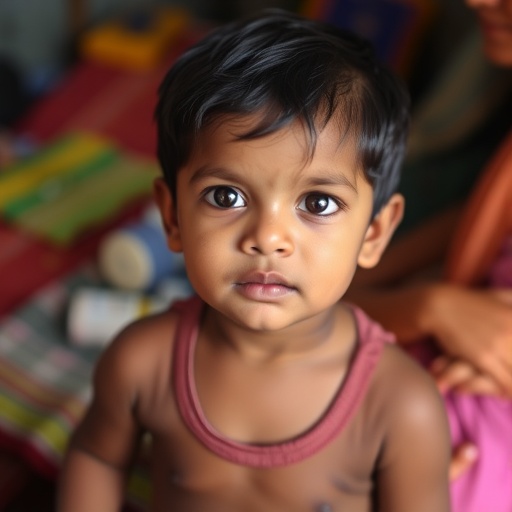In a provocative new study titled “Is Son-only family the route of India’s fertility transition?” published in the Journal of Population Research, researchers Bibek Das, Naghma Sharif, and Suraj Kumar delve into the complex interplay between familial structures and reproductive trends in India. The study addresses a trend frequently overlooked in demographic discussions—son preference and its implications for fertility transition in the subcontinent. The authors assert that while the global narrative often focuses on women’s empowerment and access to family planning, the entrenched cultural biases favoring male offspring pose significant barriers to a comprehensive understanding of India’s fertility dynamics.
The paper explores the phenomenon of son-only families in India, examining how prevalent cultural norms dictate familial desires for male children. This culturally ingrained son preference not only influences individual reproductive choices but also the broader evolutionary landscape of population dynamics. The authors meticulously document how these preferences perpetuate a high birth rate and impact the overall fertility transition in India, suggesting that addressing gender biases is crucial for the intended outcomes of fertility policies.
Of particular interest in the authors’ findings is the correlation between son-preference and declining fertility rates. Through extensive data analysis and ethnographic studies, the research delineates key patterns demonstrating that although fertility rates are decreasing across India, families with only daughters often choose to have more children out of a perceived need for a male heir. This paradox illustrates how societal expectations can lead to higher fertility rates contrary to the intended goals of many governmental initiatives aimed at population control.
The researchers also emphasize the demographic anxieties fueled by son preference. In many Indian communities, a man’s lineage and the continuation of family name are closely tied to the birth of male children. This cultural imperative engenders a cycle of risk-taking regarding reproductive health, as families often engage in repeated pregnancies, increasing health risks for women and contributing to the health crisis in reproductive services. As the study suggests, the implications reach far beyond personal reproductive decisions; they reflect deep-rooted social structures that govern familial dynamics.
Further, the study highlights how advances in technology and healthcare have simultaneously empowered women while also perpetuating son preference. For example, access to sex-selective technologies has led to an increase in female infanticide and gender-based abortion practices. Such phenomena not only skew gender ratios but also create societal imbalances that will manifest in the coming years, as fewer females will engage in family formation and relationships. This technological empowerment, when coupled with existing cultural biases, creates a complex narrative that cannot be overlooked in future demographic studies.
At a deeper level, Das, Sharif, and Kumar interrogate existing policies surrounding fertility. The researchers call attention to the inadequacy of the current policy framework in addressing son preference directly. They argue that while many initiatives target women’s health and education, without explicit considerations of the son preference culture, these policies cannot achieve their desired outcomes. The disconnect between present reproductive health policies and cultural realities underlines the need for tailored approaches that directly address familial attitudes towards gender.
The analysis presented in the paper is supported by rich qualitative interviews that illustrate the emotional and psychological dimensions of fertility decisions in son-preferred families. Many respondents articulate their profound anxiety about the implications of having daughters in a patriarchal society. This balance of personal experiences coupled with statistical modeling provides a comprehensive view of how individual decisions are influenced by broader cultural narratives.
Another critical aspect explored in the study is how son preference intersects with socio-economic status. The researchers find that wealthier families may have more significant financial freedom to attempt multiple pregnancies in pursuit of creating a male heir, further entrenching son preference. In contrast, lower-income families face compounded health risks with repeated pregnancies, leading to a cycle of poverty exacerbated by demographic pressures. This intersectionality of class and gender illustrates the multifaceted nature of the fertility transition, demanding multifactorial approaches in policy.
The study also closes the gap between demography, sociology, and anthropology by integrating insights from various disciplines. The authors argue that cultural understanding is critical for informing demographic trends, as purely statistical approaches may overlook key social dynamics that drive reproductive behavior. By encouraging interdisciplinary dialogue, the researchers hope to inspire future studies to explore the comprehensive influences that shape reproductive choices in different socio-cultural contexts.
In conclusion, Das, Sharif, and Kumar’s work presents an urgent call for a re-examination of family planning policies in India. Acknowledging the deeply embedded cultural biases surrounding son preference is not merely an academic exercise; it has profound implications for public health, societal structure, and national development. The study underscores the importance of addressing gender biases not only to reduce fertility rates but to foster a more equitable and sustainable population framework.
Advocating for a mix of policy-driven solutions along with community-based interventions, the authors propose strategies to realign cultural norms by valuing daughters and educating families about gender equity. They posit that the path towards a successful fertility transition in India is not predicated only on governmental initiatives or healthcare access but also hinges on societal change and the dismantling of harmful cultural beliefs about gender.
As this critical work adds yet another dimension to the complex tapestry of India’s fertility landscape, it beckons readers, policymakers, and scholars alike to rethink existing narratives centered on reproductive health. The authors advocate for a future where all children, regardless of gender, are embraced and valued, charting a path towards an equitable society.
Subject of Research: The impact of son preference on fertility transition in India.
Article Title: Is Son-only family the route of India’s fertility transition?
Article References:
Das, B., Sharif, N. & Kumar, S. Is Son-only family the route of India’s fertility transition?.
J Pop Research 42, 51 (2025). https://doi.org/10.1007/s12546-025-09405-x
Image Credits: AI Generated
DOI: 10.1007/s12546-025-09405-x
Keywords: Son preference, fertility transition, India, demographic trends, reproductive health, gender bias, cultural norms, socio-economic status.




